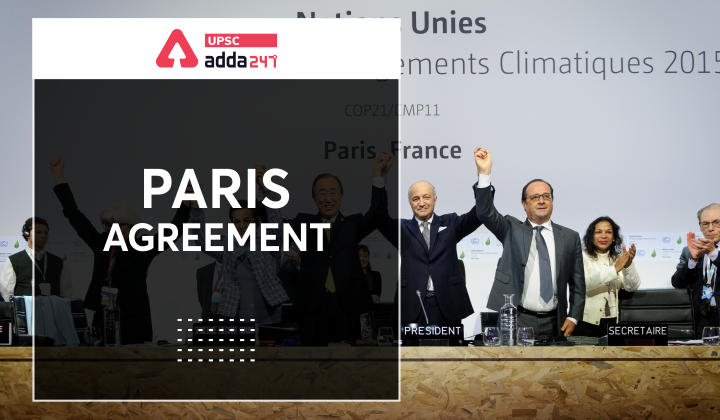Table of Contents
The Paris Agreement: Relevance
- GS 3: Conservation, environmental pollution and degradation, environmental impact assessment.
What is Paris Climate agreement?
- The Paris Agreement is a legally binding international treaty on climate change. It was adopted by 196 Parties at COP 21 in Paris in 2015 and entered into force in 2016.
- For the agreement to enter into force, at least 55 countries representing at least 55% of global emissions had to deposit their instruments of ratification.
- It is the second-most important COP after Kyoto protocol .
Paris Agreement Goals
- Its goal is to limit global warming to well below 2, preferably to 1.5 degrees Celsius, compared to pre-industrial levels.
How Paris Agreement COP 21 works?
- Article 6 Paris Agreement: The Paris Agreement works on a 5- year cycle of increasingly ambitious climate action carried out by countries. By 2020, countries submit their plans for climate action known as nationally determined contributions (NDCs).
NDCs
- In their NDCs, countries communicate actions they will take to reduce their Greenhouse Gas emissions in order to reach the goals of the Paris Agreement UNFCCC.
- Countries also communicate in the NDCs actions they will take to build resilience to adapt to the impacts of rising temperatures.
Long-Term Strategies
- To better frame the efforts towards the long-term goal, the Paris Agreement invites countries to formulate and submit by 2020 long-term low greenhouse gas emission development strategies (LT-LEDS).
- LT-LEDS provide the long-term horizon to the NDCs. Unlike NDCs, they are not mandatory. Nevertheless, they place the NDCs into the context of countries’ long-term planning and development priorities, providing a vision and direction for future development.
20/20/20 targets
- Carbon Dioxide emissions reductions by 20%,
- Work on increasing the renewable energy market share by 20%
- Target to increase energy efficiency by 20%
Paris Agreement India
- India has pledged to reduce emissions intensity per unit GDP by 33-35% of 2005 levels.
- India aims to reach 40% of installed capacity from non-fossil fuels.
- India targets 175 GW of renewable energy generation by 2022.
- India plans to enlarge forest cover to absorb 5 billion tonnes worth of carbon dioxide.
- India will reduce dependence on fossil fuels through levies and reduction in subsidies.
- India exhorted on the principles of equity and differentiated responsibilities
- India expects developed countries to mobilize 100 billion US dollars annually by 2020 for mitigation and adaptation in developing countries.
Paris Agreement for Climate Change: Key takeaways
- Global peaking and ‘climate neutrality’: To achieve this temperature goal, Parties aim to reach global peaking of greenhouse gas emissions (GHGs) as soon as possible, recognizing peaking will take longer for developing country Parties, so as to achieve a balance between anthropogenic emissions by sources and removals by sinks of GHGs in the second half of the century.
- Mitigation: The Paris Agreement 2015 establishes binding commitments by all Parties to prepare, communicate and maintain a nationally determined contribution (NDC) and to pursue domestic measures to achieve them. It also prescribes that Parties shall communicate their NDCs every 5 years and provide information necessary for clarity and transparency.
- Developed countries should continue to take the lead by undertaking absolute economy-wide reduction targets, while developing countries should continue enhancing their mitigation efforts.
- Sinks and reservoirs: The Paris Agreement also encourages Parties to conserve and enhance, as appropriate, sinks and reservoirs of GHGs, including forests.
- Adaptation: The Paris Agreement establishes a global goal on adaptation – of enhancing adaptive capacity, strengthening resilience and reducing vulnerability to climate change in the context of the temperature goal of the Agreement.
- Loss and damage: The Paris Agreement recognizes the importance of averting, minimizing and addressing loss and damage associated with the adverse effects of climate change, including extreme weather events and slow onset events, and the role of sustainable development in reducing the risk of loss and damage.
- Finance: Developed countries intend to continue their existing collective goal to mobilise USD 100 billion per year by 2020 and extend this until 2025. A new and higher goal will be set for after this period.
- Technology: The Paris Agreement establishes a technology framework to provide overarching guidance to the well-functioning Technology Mechanism. The mechanism is accelerating technology development and transfer through it’s policy and implementation arms.
- Global Stocktake: A “global stocktake”, to take place in 2023 and every 5 years thereafter, will assess collective progress toward achieving the purpose of the Agreement in a comprehensive and facilitative manner. Its outcome will inform Parties in updating and enhancing their actions and support and enhancing international cooperation on climate action.
Also Read:
| AFSPA Explained: Know everything about the Act | Underutilized POSHAN Outlays | Online Gaming in India 2021: Rajya Sabha Flags Concerns | Digitalisation of Agricultural Sector: Steps by Government |
| Smart Cities Mission Extended | 15th Finance Commission | State Finances: A Study of Budgets of 2021-22 | Large Hadron Collider: Ghost Particles Detected in LHC for the First Time |
| The History of Backward Classes Commission And the Sub-Categorisation of OBCs | Elderly Population Of India: Expert Committee On Longevity Finance | Impact of US Inflation in India | Pradhan Mantri Awas Yojana- Gramin |



 TSPSC Group 1 Question Paper 2024, Downl...
TSPSC Group 1 Question Paper 2024, Downl...
 TSPSC Group 1 Answer key 2024 Out, Downl...
TSPSC Group 1 Answer key 2024 Out, Downl...
 UPSC Prelims 2024 Question Paper, Downlo...
UPSC Prelims 2024 Question Paper, Downlo...




